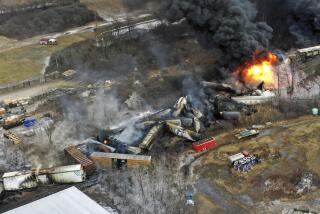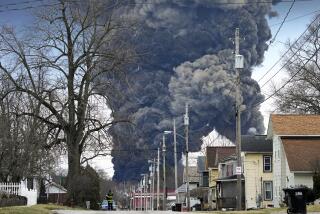New York train crash inquiry focuses on engineer’s actions
- Share via
NEW YORK — The brakes on a passenger train that sped into a curve at 82 mph before derailing were functioning properly, and the engineer was working his regular shift on a familiar route and should have been fully rested, investigators said Tuesday as attention focused on the operator’s actions before the deadly crash.
Tests showed that neither the engineer, William Rockefeller, nor the three assistant conductors on the Metro-North Railroad train had consumed alcohol, Earl Weener of the National Transportation Safety Board told reporters.
Weener refused to comment on media reports that Rockefeller had told investigators he had “zoned out” seconds before the crash. [Updated, 9:15 p.m.: But the head of the Assn. of Commuter Rail Employees, Local Division 1, said Rockefeller had admitted losing focus just before the derailment early Sunday.
“I don’t think he realized how fast he was going.... It’s the equivalent of all of us when we drive a car. You tend to look at something so long,” Anthony Bottalico told reporters. He noted that the train had been traveling for 20 minutes since its last stop.]
Weener has said no details of the statements made by Rockefeller and other crew members will be released until investigators have completed interviews. But information gleaned so far has pointed to operator error, as other factors, such as mechanical failure, are eliminated.
Among other things, the NTSB has discovered that the train, which should have been traveling 30 mph when it rounded the curve, was going 82 mph — even faster than the 70-mph limit on the straight portion of track — and that the brakes were not applied until five seconds before the rear engine stopped.
By then, all seven passenger cars being pushed by the locomotive had left the tracks in the Spuyten Duyvil section of the Bronx, about 10 miles from the train’s final destination, Grand Central Terminal. Four passengers were killed and dozens injured.
“Simply put … there’s no indication the brake systems were not functioning properly,” Weener said, after investigators had determined that brake checks performed before and during the train’s journey showed no anomalies. Asked whether, based on what they had learned, investigators were leaning toward declaring human error the cause of the crash, Weener said, “Frankly, we walk into an investigation like this and open up all of the possibilities, and then one by one we try to say, ‘This one is not likely, this one is not likely,’ and see what we’re left with.”
Among information that has yet to be determined: the results of drug tests on the crew; whether the assistant conductors had expressed worries about the train’s speed; and at what point the “dead man’s pedal” in the engineer’s cab, which serves as an emergency braking system, was activated.
The derailment was the first crash in Metro-North’s 30-year history to kill passengers, but the latest in a string of recent incidents that have led political leaders to call for greater scrutiny of the railroad, the nation’s second-busiest.
Gov. Dannel P. Malloy of Connecticut, where a Metro-North collision in May injured more than 70 people, called Tuesday for monthly updates from the railroad to monitor safety improvements. “Metro-North has got to get its house in order,” Malloy said.
Critics of Metro-North say the crash has underscored the need for installation of technology known as positive train control, or PTC, which is designed to slow or stop trains before accidents. A federal mandate requires the system to be in place on railroads by the end of 2015, but some rail companies, including Metro-North, have said they should have more time to implement it.
“I’d be very loath to be more flexible or grant more time,” said Sen. Richard Blumenthal (D-Conn.).
The system relies on computers, digital radio systems and global positioning devices to guide trains and stop them automatically in an emergency.
Weener said it was not clear whether the system would have prevented Sunday’s crash, but he described it as “proven technology” in preventing crashes and speed-related derailments. The NTSB has recommended its implementation for more than 20 years.
“We know that human error can’t be eradicated, and that PTC is capable of supplementing the human operation,” Weener said.
More to Read
Sign up for Essential California
The most important California stories and recommendations in your inbox every morning.
You may occasionally receive promotional content from the Los Angeles Times.











